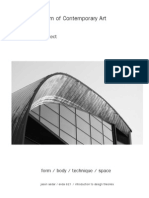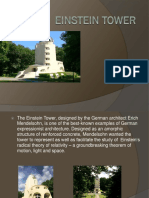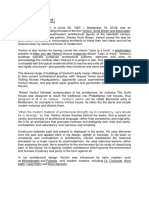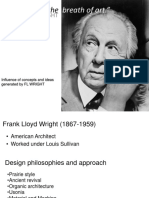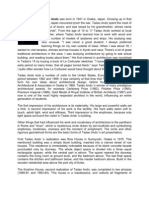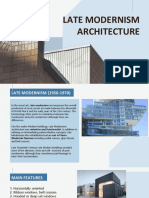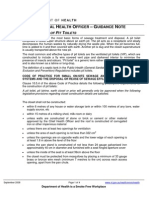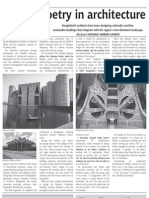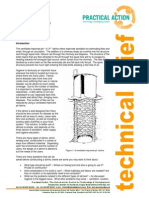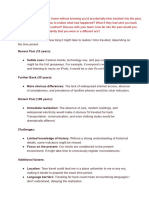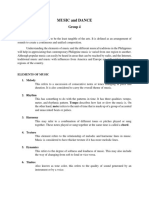Mass N Void
Mass N Void
Uploaded by
Kiran BasuCopyright:
Available Formats
Mass N Void
Mass N Void
Uploaded by
Kiran BasuOriginal Title
Copyright
Available Formats
Share this document
Did you find this document useful?
Is this content inappropriate?
Copyright:
Available Formats
Mass N Void
Mass N Void
Uploaded by
Kiran BasuCopyright:
Available Formats
Architectoni.
ca [2012], Copyright CCAAS
Nilgn Kulolu, et. al., Architectoni.ca 2012, 2, 131-137
Perceptual and Visual Void on the Architectural Form:
Transparency and Permeability
Nilgn Kulolu* and Tlay amlolu
Assist. Prof. Dr., Karadeniz Technical University, Faculty of Architecture, Department of Architecture 61080
Trabzon Turkey, E-mail: nkuloglu@hotmail.com, *corresponding author
Architect MSc, Avrasya University, Department of Architecture 61080 Trabzon Turkey, E-mail:
tulaysamlioglu@hotmail.com
doi:10.5618/arch.2012.v1.n2.4 || Received: 15-02-2012, Accepted: 08-07-2012, Available online: 17-07-2012
Abstract
1. Introduction
Form, space and voids are the basic elements used
in architectural design process. In this paper, the
concept of void is addressed in relation to the
architectural form. Voids in architectural form are
classified into two main headings by examining a
great number of examples in terms of the effects
created on the form: cognitive and functional.
Cognitive voids are related to perception and are
used to create various visual effects. As the heading
indicates, functional voids are created to meet
certain needs and desires. We further classified
cognitive voids under three sub-headings as
conceptual, perceptual/visual, and sculptural/
monumental. Functional voids were also divided
into six sub-headings; entrance, corner, balcony/
terrace, gallery/atrium/courtyard, surface, transition/circulation. Our discussion is focussed on
perceptual/visual voids, which is classified under
the cognitive voids. Perceptual/visual voids can be
explained with two sub-concepts: transparency
and permeability. Perceptual effects desired to be
emphasized with the help of voids are explained by
the concept of transparency, while the visual
effects are explained by the concept of
permeability. Although void is one of the main
elements used in architectural forms, it has not
been discussed in this context previously. With the
selected examples, here we showed that the
perceptual/visual voids classified under cognitive
voids can be associated with well known
architectural concepts, such as transparency and
permeability. Moreover, the void classification
made in this study may be useful in comprehending of architectural form.
1.1. Form and Space. Space and form have been
present as the two inseparable concepts since the
beginning of architectural activities. Since the day
aesthetic and beauty concerns existed, there have been
aesthetic statements on form and this process still goes
on (Vitruvius 1960 [1]; Corbusier 1986 [2]; Tunal
1979 [3]; Erzen 2007 [4]). Considering the formgeometry-architecture relationship, in ancient times,
square, circle and triangle were the prominent shapes.
Forms deriving from these shapes were frequently
used, as they were considered to be the most beautiful.
Thus, basic geometrical forms were dominant in the
architecture of the ancient times due to this and
similar reasons (Table 1).
Keywords: Form; Void; Perceptual Void; Visual
Void; Transparency; Permeability
It would be insufficient to mention only the
discussions about the physical dimension while
dealing with the space and form concepts. It is
because both form and space include semantic
expressions, as well. Since ancient times, considering
the use of basic forms in architecture, it can be said
that the pure geometry of form has been deformed day
by day, additions and deductions have increased, and
the void effect created in interior and exterior space is
handled not only with functional, but also formal
concerns. The basic forms dominating the architecture
in the course of history are reshaped based on the
changes in the design perspective and are transformed
under the effect of these changing design perspectives.
When we examine the historical development of
architecture, we clearly see that the architectural space
and therefore form have undergone physical and
semantic changes (amlolu& Kulolu 2009) [5].
The concepts regarding space and form are moved
from one to the other in the course of history. Also,
this change that space and form have undergone
together should be considered based on the change
and development in theory, discourse, technology,
material, time etc. Depending on this development and
change process summarized above, architectural form
is also evident to change its expressions.
131
http://ccaasmag.org/ARCH
Architectoni.ca [2012], Copyright CCAAS
Nilgn Kulolu, et. al., Architectoni.ca 2012, 2, 131-137
Table 1. Form Concept in Ancient Architecture1
Pyramids of Giza/Egypt2
Parthenon/Greek3
2. Void: as a Concept
The lexical meaning of the void is cavity, hole,
unclosed space according to its Turkish translation
boluk, (URL1) [6]. And in English, it is defined as
nullity in the dictionary. In another definition, void
is space with no bodies in and identified as the
opposite meaning of fullness (Hanerliolu 1993)
[7].
Conceptually void is defined as nonexistence,
nullity, while spatially it gains a different meaning
than its dictionary definitions. Void in space is a place
incorporating activity. Therefore, this void created in
form based on space indeed creates a place
(amlolu& Kulolu 2009) [5].
Space and form have both abstract and concrete
meanings. With this aspect, void in the space and form
has been the subject of various studies in different
dimensions. However, in most of these studies, the
interpretations and discussions are generally on the
form itself (Ching 2002 [8]; nceolu&nceolu 2004
[9]; Usta 1994 [10]).
Voids created in the form can be classified in
various ways physically (Onat 1995) [11]. Void can
be discussed on various examples depending on the
trinity of form, function and perception (amlolu&
Kulolu 2009) [5]. As a result of these and other
similar classifications and discussions, one of the
authors of this paper came up with a classification
from the idea that void is not only a concrete entity,
but both a concrete and abstract concept. According to
this classification, voids created in the architectural
form may be visualized as shown in Table 2
(amlolu 2010) [12]. As seen in the table, the types
of void are divided into two groups: cognitive and
functional, and under these two headings, other subheadings are classified. The corresponding arrows are
used to mean that any type of void may be seen in a
Colosseum/Rome4
Pantheon/Rome5
single architectural form with another type of void in
its own class or in another class.
Cognitive voids are related to the perception.
Cognitive void classification is made based on either
the effect that architect desires to create or the effect
created on user by the void. These voids are classified
as conceptual, perceptual/visual, and sculptural/
monumental. For example; Holls design solution was
that the Simmons Hall Building would metaphorically
work as a sponge. According the Table 2, void type of
this building is classified as conceptual void.
Functional voids are related to the usage of the
space. These voids are designed for functional
activities. Functional voids are classified as entrance,
corner, balcony/terrace, gallery/atrium/courtyard,
surface, and transition/circulation. For example; most
of the buildings of Mario Botta are designed an
entrance void on the building form.
According to the theoretical classification given in
the Table 2, this paper exemplifies the void under the
heading perceptual/visual voids and examines the
relation of voids created in the architectural form.
Perception becomes one of the main concepts of
this study. Perceiving is a process related to all senses,
but the sense of vision is known to be more prominent
than the other senses in this context. Visual
perception, visual thinking and the relation between
these concepts are the subject of a number of studies
(Arnheim 1969 [13]; Gibson 1950 [14]).
In this study, perception is evaluated as a metaheading, and in the perception process, perceptual and
visual senses are the sub-headings of the process.
Therefore, the perception of void is assumed to occur
under all the headings given in Table 2, and the
definition of perceptual/visual void is evaluated in this
context.
132
http://ccaasmag.org/ARCH
Nilgn Kulolu, et. al., Architectoni.ca 2012, 2, 131-137
Architectoni.ca [2012], Copyright CCAAS
Table 2. Classification of Voids.
VOID
Mass/ Spatial
Cognitive Voids
Functional Voids
Entrance
Conceptual
Corner
Perceptual/Visual
Balcony/Terrace
Transparency
Permeability
Sculpture/Monumental
Gallery/Atrium/Courtyard
Surface
Transition/Circulation
3. Void: Perceptual/Visual
The primary purposes of such voids are to create a
wealth of perception. Perceptual/visual voids provide
users with various opportunities. These can be
summarized as the ability to view the surrounding
area from different angles, creating space for various
activities, making a rich environment in terms of the
user in the form itself, and thus in the space and etc.
Perceptual/visual voids directly indicate two subheadings. These are the concepts of transparency and
permeability. Although these concepts have been
widely discussed on architectural buildings before,
they have never been handled in the context of the
void theme. However, buildings creating a perceptual
void emphasize transparency, while those creating a
visual void emphasize permeability.
Depending on the theoretical classification of void
given in Table 2, can be seen the relationship between
transparency and permeability concepts with
perceptual/visual voids.
3.1. Void: Perceptual. Sometimes, void is not
physically created in the form itself. Instead, a sense
of void can be created in the whole form. On such
examples, the sense of void is obtained by using the
materials. The form itself might be a cube, sphere,
prism and etc. While the form goes under no
processes, the created effect is evident as a kind of
void perception. One of the ways to enable this is to
build the form using materials like glass and steel to
create the void effect. Thereby, the perceptual void in
the form is actually created depending on the effect of
transparency created by the material.
The transparency concept has been widely
discussed and studied in the architectural literature
before (Rowe&Slutzky 1963 [15]; Corra 2009 [16]).
However, that a perception of void can be created in
the form with the help of transparency has not been
mentioned much. Perceptual voids directly match up
with the transparency concept. In such examples, the
form does not thrust itself forward as a whole, what is
in the foreground is the transparency effect. For
instance, when a cube, triangular prism or rectangular
prism is built with a transparent material, it gets
harder to perceive these prisms. Instead, the whole
space is provided with a void effect. In this case, the
transparency effect gets ahead of the fact that the form
is perceived as a prism. The element to create this
effect is transparency.
Such architectural examples are generally
interpreted by critics or their designers depending on
the transparency effect. This paper aims to put forth
that transparency in the architectural form creates
some kind of a void effect. The examples selected to
explain this situation in the study are among the
striking ones in the literature.
In Table 3, the examples where the perceptual
effect of void is obtained by transparency are given in
chronological order and the perceptual void effect
created by transparency is explained based on the
literature.
133
http://ccaasmag.org/ARCH
Architectoni.ca [2012], Copyright CCAAS
Nilgn Kulolu, et. al., Architectoni.ca 2012, 2, 131-137
Table 3. Perceptual Voids
Farnsworth House, 1946
Mies van der Rohe
At Farnsworth House, the virtues of transparency endure,
pure and powerful. The house dissolves the alienating
division between outside and inside, letting nature and the
change of seasons become a seamless part of the
experience of the building (URL2) [17]. Maritz
Vandenburg has written about the Farnsworth House:
Every physical element has been distilled to its
irreducible essence. The interior is unprecedentedly
transparent to the surrounding site and also
unprecedentedly uncluttered in itself (URL3) [18].
The Louvre Pyramid, 1989
I.M. Pei
The Louvre Pyramid may be seen as the formal element
which reconciles the paired design strategies of axial
deduction and generation of rotated squares just as its
transparency may be seen as the quality which figuratively
and literally establishes the relationship between the
surface and underground levels of the project. The
pyramid is both the lens that focuses the existing geometry
of the court and the prism which translates that geometry
into the subterranean space (Rustow 1990) [19].
R128 House, 1998
Werner Sobek
The glass and steel R128 House is located on a steeply
sloped site with panoramic views of Stuttgart. Although
this house seems sterile and completely transparent, it is a
home where comfort and privacy issues for the inhabitants
have been met. The design resulted from his desire to have
an all glass house with unencumbered views of the
surrounding city and countryside that would also employ
contemporary engineering concepts for sustainable
buildings (URL4) [20].
Rose Centre: Earth & Space, 2000
Polshek Partnership
The Rose Centre for Earth and Space features a large
sphere housed by a glass cube which serves as a symbol of
the buildings purpose (URL5) [21]. Architect Polshek
describes the design concept for the Rose Centre as a
cosmic cathedral. The transparent walls are a metaphor
for the revelation that science offers (URL6) [22].
Architects said of their design, Critical to the design
concept is the spheres apparent disengagement from the
enclosing structure and from its transparent curtain wall
(URL5) [21].
Industrial Designer House, 2004
Koji Tsutsui
Japanese Architect Koji Tsutsui has designed this modern
house in Tokyo, Japan, for an industrial designer, with a
distinctly industrial edge. Industrial Design House was
planned with a living/dining area and gallery at its core,
featuring a bare white backdrop and tall ceilings that invite
the flood of natural light. Each room provides its own
individual feel and function, but they are all interwoven via
the basic elements of architecture floor, wall, ceiling,
stairs, void and openings, according to Best House Design
(URL7) [23].
134
http://ccaasmag.org/ARCH
Architectoni.ca [2012], Copyright CCAAS
Nilgn Kulolu, et. al., Architectoni.ca 2012, 2, 131-137
Table 4. Visual Voids
Tbilisi Ministry Building, 1975
George Chakhava
The design is based on a concept named Space City
Method. The idea is to use and cover less ground and give
the space below the building back to nature. The architects
reference was a forest, the cores are like the trunk, the
horizontal parts the crowns. Between the earth and crowns
there is a lot of free space for other living beings, which
create one harmonious world with the forest. The concept
was used by other architects, too (URL8) [28]. This idea
also suggests the concept of visual permeability.
Le Grande Arch, 1990
J Otto von Spreckelsen
Danish architect Johann Otto von Spreckelsen designed the
winning entry to be a 20th century version of the Arc de
Triomphe: a monument to humanity and humanitarian
ideals rather than military victories (URL9) [29]. This idea
has transformed the building into a virtual urban door.
Created visual void has become an element, on the
historical axis of the city by use of the physical and
perceptual permeability through providing support and
strengthen the image of the city.
CCTV Building, 2004
OMA
Scheeren situates the CCTV within a field of spatial
forces: the texture of the Forbidden City paired with the
void of Tiananmen Square together constitute two strong
forces of gravity that define Beijings character. The
building introduces accessibility and accountability. The
architects suggest that the buildings glass faade provides
the prevailing architectural metaphor: transparency&
accessibility (Mattern 2008) [30]. The huge void in middle
of the form has created a visual perception and effect with
a big window to the city.
Mirador Building, 2005
MVRDV
MVRDV is well-known for its philosophy of densification
and multiple space use (URL10) [31]. The most impressive
element of the building is the incredible void of it shape.
The void is used by the neighbourhood as a meeting area
and playground. The views from the void are incredible,
across to the Guadarrama Mountains, because Mirador is
one of the highest buildings in the area. (URL11) [32]. The
big void that is created on the building form provides a
different visual effect about the city environment.
Gas Natural Office Building, 2008
E. Miralles & B. Tagliabue
That is why we have made a proposal where the interest
lies in the fragmentation of the constructible volume into a
series of constructions that at the end form a unified
volume, which responds to different scales and in clear
relation to the nearby apartment buildings. By forming a
great doorway which allows the opening up of the district
of La Barceloneta and a singular public space that brings
the construction to the ground, until it forms an urban
landscape of different dimensions (URL12) [33].
135
http://ccaasmag.org/ARCH
Architectoni.ca [2012], Copyright CCAAS
3.2. Void: Visual. In such buildings, the form is
shaped according to the void. The objectives include
bringing the void in the foreground, rather than the
building or the form, and making it perceived. The
location of the building is one of the primary and
important reasons to create such voids. These voids
bring different perspectives to the city and the city
dwellers from various directions of the building. They
aim at opening a door or window to the environment
surrounding them, strengthening and guiding the
visual perception. In order to fulfil these objectives,
depending on the situation and size of the void,
permeability is tried to be created. Therefore, visual
void in a sense indicates the concept of permeability.
Permeability is one of the concepts that have
recently been discussed in the architectural environment. Permeability is defined in a number of ways
such as providing the option to go from one place to
another (Bentley 1985) [24], that something can
move in some other thing (Stamps, 2003) [25] etc.
and can be classified in a number of ways.
In this study, when the void is in contact with the
ground, physical permeability is assumed to occur,
while in other cases, perceptual permeability is
assumed to be obtained. Physical permeability is
thought to offer the users the options to move
(Carmona et al. 2003) [26].
On the other hand, perceptual permeability is
associated with reading, understanding and comprehending the environment. Permanent images are
known to be seen in especially distinctive spaces with
a high readability level (Sternberg 2000) [27]. In this
sense, visual voids indicating the permeability concept
are inevitably important in urban spaces.
In Table 4, the examples where the visual effect of
void is obtained by permeability are given in a
chronological order and the visual void effect created
by permeability is explained based on the literature.
4. Conclusion: Perception &Void &Concepts
This study that examines the void concept in relation
to geometry has made a classification and tried to
explain perceptual/visual voids in the classification
with the help of transparency/permeability concepts.
In this context, perceptual voids are related with
transparency, while visual voids with permeability.
The discussions on the examples have brought about
some common findings;
While studying the building examples, transparency
and permeability concepts are seen to be used to
explain the space in both void types. What
distinguishes between these void types is considered
to be related to not only conceptual, but also physical
properties. It is because transparency and permeability
are concepts that can occasionally be expressed in
both of the void types at the same time.
Nilgn Kulolu, et. al., Architectoni.ca 2012, 2, 131-137
Physical difference properties are about how the
void is created. Perceptual voids are formed by the
material use, while visual voids occur as a result of
reductions made in the form. In this case, the physical
difference between the two types shows itself like
this: in buildings with a perceptual void, the void does
not exist physically, while in buildings with a visual
void, the void reveals itself in a very striking way.
In the types of perceptual void, transparency and
permeability are seen to be the concepts used together
from time to time in defining the form. In such
examples, transparency is a concept that the form
should include. The said permeability is not physical,
but perceptual. In buildings with a perceptual void,
that the readability level is high and distinctive
features are prominent result in the occurrence of
permanent images (Sternberg 2000) [27] and thus, the
perceptual permeability can be mentioned.
Whereas in the types of visual void, the effect in
space is explained together with the use of
transparency and permeability concepts. However, the
said permeability in the types of visual void is mostly
a physical one; like taking the users from one place
to another (Bentley 1985 [24]; Stamps 2003 [25]).
Nevertheless, such voids might be included transparency and permeability concepts together at times.
Considering the examples, it is possible to say that
the most evident feature to distinguish between the
two void types is the contrast between absence and
presence. Only transparency and permeability
concepts are thought to be insufficient to express this
difference. In the classification of cognitive voids, if
the void does not exist physically, it is a perceptual
void, but if it exists physically, it is a visual void.
References
[1] Vitruvius, The Ten Books on Architecture,
Translated by: M. H. Morgan, Dover Publications,
Inc., New York, 1960.
[2] Le.Corbusier, Towards a New Architecture, Dover
Publications, Inc., New York, 1986.
[3] Tunal, ., Estetik, Cem Yaynevi, stanbul, 1979.
[4] Erzen, J., Paradigms for a New Aesthetics in a
Globalizing
World,
Changing
Historical
Processes-Changing Concepts, 1, 2007, 139-147.
[5] amlolu, T.; Kulolu, N., The Concept of Void
as Spatial Effect, Livenarch IV: Re/De
Constructions in Architecture, 4th nternational
Congress Livable Environments & Architecture,
Trabzon, Turkey, Proceedings Volume I, 2009,
145-162.
[6] URL1: TDK Szl,
http://www.tdkterim.gov.tr/seslisozluk/?kategori=y
azimay&kelimesec=010422
136
http://ccaasmag.org/ARCH
Architectoni.ca [2012], Copyright CCAAS
Nilgn Kulolu, et. al., Architectoni.ca 2012, 2, 131-137
[7] Hanerliolu, O., Felsefe Ansiklopedisi:
Kavramlar ve Akmlar, Cilt I (A-D), Remzi
Kitabevi, stanbul, 1993.
[21] URL5:
http://weburbanist.com/2009/01/12/creativemodern-and-postmodern-museum-designs/
[8] Ching, F.D.K., Mimarlk: Biim, Mekn ve
Dzen, YEM Yayn, stanbul, 2002.
[22] URL6:
http://www.architectureweek.com/2000/0621/desig
n_3-1.html
[9] nceolu, M.; nceolu, N., Mimarlkta Sylem,
Kuram ve Uygulama, Tasarm Yayn Grubu,
stanbul, 2004.
[23] URL7: http://www.trendir.com/housedesign/modern-industrial-design-house.html
[10] Usta, A., Anadolu Mimarlnda Form Analizi,
Unpublished Dissertation Thesis, KT Fen
Bilimleri Enstits, Trabzon, 1994.
[24] Bentley, I., Responsive Environments: A Manual
for Designers, The Architectural Press, London,
1985.
[11] Onat, E., Mimarlk, Form ve Geometri, YEM
Yayn, stanbul, 1995.
[25] Stamps, A.E., Permeability and Environmental
Enclosure, Perceptual and Motor Skills, 96, 2003,
1305-1310.
[12] amlolu, T., Mimari Formda Boluun Kefi,
Unpublished Master Thesis, KT Fen Bilimleri
Enstits, Trabzon, 2008.
[13] Arnheim, R., Visual Thinking, University of
California Ltd. Press, London, England, 1969.
[14] Gibson, J.J., The Perception of the Visual World,
Cambridge, Mass, 1950.
[15] Rowe, C.; Slutzky, R., Transparency: Literal and
Phenomenal, Perspecta, 8, 1963, 45-54.
[16] Corra, S.M., Transparencies: Reflections on the
Evolution Recurrences and Alternatives under an
Environmental Perspective, PLEA2009 26th
Conference on Passive and Low Energy
Architecture, Quebec City, Canada, 22-24 June,
2009.
[17] URL2:
http://www.lynnbecker.com/repeat/Farnsworth/farn
sworth.htm
[18] URL3:
http://www.farnsworthhouse.org/history.htm
[19] Rustow, S. L., Transparent Contradictions: Peis
Pyramid at the Louvre, Paper given at the Annual
Meeting of the Society of Architectural Historians,
Boston, 1990.
[26] Carmona, M.; Heath, T.; Oc, T.; Tiesdell S.,
Public Places Urban Spaces, The Dimensions of
Urban Design, Architectural Press, Oxford, 2003.
[27] Sternberg E., An Integrative Theory of Urban
Design, in: Urban Design Reader, Carmona M.;
Tiesdell S., Architectural Press. 2000.
[28] URL8:
http://en.wikipedia.org/wiki/Tbilisi_Roads_Ministr
y_Building#cite_ref-Chakhava_.28Junior.29_1-3
[29] URL9:
http://www.mimoa.nl/scripts/createGuide.php?guid
e_id=3399
[30] Mattern, S.; Broadcasting Space: China Central
Televisions New Headquarters, International
Journal of Communication 2, 2008, 869-908.
[31] URL10: http://en.wikipedia.org/wiki/MVRDV
[32] URL11:
http://www.galinsky.com/buildings/mirador/index.
html
[33] URL12: http://www.earchitect.co.uk/barcelona/torre_de_gas_natural_em
bt.htm
[20] URL4:
http://www.architectureweek.com/2008/0319/buildi
ng_1-1.html
Notes:
1
Drawings of all buildings in this article were prepared by Tlay amlolu.
Photograph: http://www.greatbuildings.com/cgi-bin/gbi.cgi/Great_Pyramid.html/cid_2203726.html
Photograph: http://www.greatbuildings.com/cgi-bin/gbi.cgi/The_Parthenon.html/cid_1825719.html
Photograph: KTU Designtrain Project Team Archive: Genosmanolu AB., Kulolu N., Asasolu A., Italy,
Rome, 2008.
5
Photograph: KTU Designtrain Project Team Archive: Genosmanolu AB., Kulolu N., Asasolu A., Italy,
Rome, 2008.
137
http://ccaasmag.org/ARCH
You might also like
- Christine Gledhill - Genre and GenderDocument28 pagesChristine Gledhill - Genre and GenderTea Majic100% (2)
- Housing and Urbanization Charles CorreaDocument36 pagesHousing and Urbanization Charles CorreaAkshat ChaturvediNo ratings yet
- Towards A Critical Regionalism: Six Points For An Architecture of ResistanceDocument3 pagesTowards A Critical Regionalism: Six Points For An Architecture of ResistanceShehzar Khan67% (3)
- Lec 3 Solid VoidDocument12 pagesLec 3 Solid VoidMaryam Saeed100% (1)
- La Tourette Monastery - Geoffrey Baker AnalysisDocument37 pagesLa Tourette Monastery - Geoffrey Baker AnalysisKavya Senthilkumar100% (1)
- Indian Institute of Management - Ahmedabad - Louis KahnDocument3 pagesIndian Institute of Management - Ahmedabad - Louis Kahntwinkle4545No ratings yet
- Architecture Without ArchitectsDocument1 pageArchitecture Without ArchitectsShivam SahuNo ratings yet
- Understanding The Poetics of ArchitectureDocument23 pagesUnderstanding The Poetics of ArchitectureDhan Cris CandelariaNo ratings yet
- The Gate of Creation-Tadao AndoDocument2 pagesThe Gate of Creation-Tadao AndoLakshiminaraayanan SudhakarNo ratings yet
- Kimbell Art Museum: Long Span StructureDocument5 pagesKimbell Art Museum: Long Span StructureNiket Pai100% (1)
- Team X BrutalismDocument20 pagesTeam X Brutalismsarath sarathNo ratings yet
- Broadbent-Design in ArchDocument3 pagesBroadbent-Design in ArchSpny Creations100% (1)
- Kolumba MuseumDocument2 pagesKolumba MuseumshankariNo ratings yet
- Ar. Tadao Ando: The Architect of LightDocument33 pagesAr. Tadao Ando: The Architect of LightyashaswiniNo ratings yet
- Kiasma Museum of Contemporary ArtDocument17 pagesKiasma Museum of Contemporary ArtrodrigoguabaNo ratings yet
- Lysistrata, The Women'S Festival, Frogs: Series Editor Ellen GreeneDocument34 pagesLysistrata, The Women'S Festival, Frogs: Series Editor Ellen Greenesoma100% (3)
- ZAHA HADID - PHAENO - Science Centre WolfburgDocument9 pagesZAHA HADID - PHAENO - Science Centre WolfburgEmiliano_Di_Pl_3393No ratings yet
- Lars SpuybroekDocument30 pagesLars SpuybroekVignesh VickyNo ratings yet
- Einstein TowerDocument14 pagesEinstein TowergayathiriNo ratings yet
- A STUDY On Alvar Aalto and His Experimentation in Villa MaireaDocument279 pagesA STUDY On Alvar Aalto and His Experimentation in Villa MaireaBojana Filipovic GeorgievskaNo ratings yet
- Tadao AntoDocument42 pagesTadao AntoGrace HenryNo ratings yet
- Rain and ArchitectureDocument33 pagesRain and Architecturegladknee100% (1)
- Tadao AndoDocument24 pagesTadao AndoAleli Luna100% (1)
- CRiTiCaL REgIoNaLiSm ArchitectureDocument3 pagesCRiTiCaL REgIoNaLiSm ArchitectureARUN GEORGENo ratings yet
- Hassan Fathy - Sustainable ArchitectureDocument5 pagesHassan Fathy - Sustainable ArchitectureangelNo ratings yet
- 00 - Architectural Criticism NotesDocument8 pages00 - Architectural Criticism NotesAmar NathNo ratings yet
- Thesis Report SPREADSDocument54 pagesThesis Report SPREADSAdil A S 191006No ratings yet
- Unit 2Document22 pagesUnit 2apoorva100% (2)
- Pneumatic StructuresDocument33 pagesPneumatic StructuresRonnie NalupaNo ratings yet
- Toa - Ii - Module - 1 Vitruvius: ArchitecturaDocument21 pagesToa - Ii - Module - 1 Vitruvius: ArchitecturaIMRAN KHANNo ratings yet
- Archi Theory Geoffrey Broadbent, OthersDocument8 pagesArchi Theory Geoffrey Broadbent, OthersKavya100% (2)
- Peter EisenmanDocument28 pagesPeter EisenmanRadhika VijayNo ratings yet
- Design Philosophies of Mies Ven Der RoheDocument17 pagesDesign Philosophies of Mies Ven Der RohePari Sonowal100% (2)
- Sustainability in ArchitectureDocument8 pagesSustainability in ArchitectureShovon Kumar BiswasNo ratings yet
- Ar. Bernard TschumiDocument50 pagesAr. Bernard TschumiLabeedAbdulrehmanNo ratings yet
- Long Span Structures: Salahuddin M. Khalid Theory of Structures YEAR-5th SEM - 9thDocument5 pagesLong Span Structures: Salahuddin M. Khalid Theory of Structures YEAR-5th SEM - 9thSalahuddin ShaikhNo ratings yet
- Sainte Marie de La Tourette (1956-1960)Document13 pagesSainte Marie de La Tourette (1956-1960)Pooja vijayNo ratings yet
- Roman ArchitectureDocument57 pagesRoman ArchitectureJohnrey Delacruz100% (1)
- Robert Venturi and Postmodernism - Vanna Venturi House and Guild HouseDocument9 pagesRobert Venturi and Postmodernism - Vanna Venturi House and Guild HouseAnqa ParvezNo ratings yet
- The Principle of Unity in ArchitectureDocument6 pagesThe Principle of Unity in Architecturecarl_bautista_30% (1)
- Literature Case Study: Row Housing On ContoursDocument20 pagesLiterature Case Study: Row Housing On ContoursLokesh Singh100% (1)
- FL Wright and His WorkDocument31 pagesFL Wright and His Worksyed fasih100% (1)
- Theory of Architecture Module IV (Calicut Univ)Document86 pagesTheory of Architecture Module IV (Calicut Univ)Thirumeni MadavanNo ratings yet
- Theory of ArchitectureDocument53 pagesTheory of ArchitecturechaplinNo ratings yet
- Architecture in TransitionDocument6 pagesArchitecture in TransitionRéka SzántóNo ratings yet
- Colin Rowe, The Present Urban Predicament'Document18 pagesColin Rowe, The Present Urban Predicament'mellacrousnof100% (1)
- ARCHIGRAMDocument9 pagesARCHIGRAMIndraja RmNo ratings yet
- C Was Born in 1941 in Osaka, Japan. Growing Up in ThatDocument4 pagesC Was Born in 1941 in Osaka, Japan. Growing Up in Thatlongho2kNo ratings yet
- Lecture 1 - Heritage DocumentationDocument5 pagesLecture 1 - Heritage Documentationtahreem shahNo ratings yet
- Vernacular and ArchitectDocument21 pagesVernacular and ArchitectdurgaNo ratings yet
- Late Modernism and Peter EisenmannDocument16 pagesLate Modernism and Peter EisenmannSakshi SharmaNo ratings yet
- Charles MooreDocument37 pagesCharles MooreRounak GodhkeyNo ratings yet
- Eco Assigment - Rafiq AzamDocument21 pagesEco Assigment - Rafiq AzamHanif Ismail100% (1)
- Case Study of Ando's Church of LightDocument239 pagesCase Study of Ando's Church of Lightm_popovicNo ratings yet
- Critical RegionalismDocument7 pagesCritical RegionalismLem PaneloNo ratings yet
- Ar - Chitra VishwanathDocument7 pagesAr - Chitra Vishwanathbarathi50% (2)
- Indian Vernacular Houses Around BangaloreDocument14 pagesIndian Vernacular Houses Around BangaloreNaveen KishoreNo ratings yet
- Critical Regionalism LectureDocument50 pagesCritical Regionalism Lecturexahidlala0% (1)
- Asian Architecture Research Final ReportDocument23 pagesAsian Architecture Research Final ReportTommy Tan75% (4)
- Tribhuvan University Institute of Engineering Pulchwok Central Campus Pulchwok, LalitpurDocument13 pagesTribhuvan University Institute of Engineering Pulchwok Central Campus Pulchwok, LalitpurKiran BasuNo ratings yet
- Tribhuvan UniversityDocument4 pagesTribhuvan UniversityKiran BasuNo ratings yet
- Residence at Hetauda - 01.07.017Document8 pagesResidence at Hetauda - 01.07.017Kiran BasuNo ratings yet
- QAP QuestionnaireDocument1 pageQAP QuestionnaireKiran BasuNo ratings yet
- Residence at Hetauda2 - 01.07.017Document12 pagesResidence at Hetauda2 - 01.07.017Kiran BasuNo ratings yet
- Literature ReviewDocument10 pagesLiterature ReviewKiran BasuNo ratings yet
- The Architecture of FOREIGN ARCHITECTS in Nepal TextDocument7 pagesThe Architecture of FOREIGN ARCHITECTS in Nepal TextKiran BasuNo ratings yet
- World Has Been Changing Its Shape in Terms of Different Parameters Such As Geographical RegionDocument1 pageWorld Has Been Changing Its Shape in Terms of Different Parameters Such As Geographical RegionKiran BasuNo ratings yet
- 3d ImagesDocument7 pages3d ImagesKiran BasuNo ratings yet
- Quantity of Cement & Sand Calculation in Mortar Quantity of Cement & Sand Calculation in MortarDocument1 pageQuantity of Cement & Sand Calculation in Mortar Quantity of Cement & Sand Calculation in MortarKiran BasuNo ratings yet
- Road ProopposalDocument40 pagesRoad ProopposalKiran Basu100% (1)
- Pre-Primary School - Asa Studio - ArchDailyDocument10 pagesPre-Primary School - Asa Studio - ArchDailyKiran BasuNo ratings yet
- Program and Bylaws of HotelDocument18 pagesProgram and Bylaws of HotelKiran BasuNo ratings yet
- Project: Restaurant at Thamel Designer: Needle Weave L Architects Job Address: Thamel, KathmanduDocument1 pageProject: Restaurant at Thamel Designer: Needle Weave L Architects Job Address: Thamel, KathmanduKiran BasuNo ratings yet
- Sales: Severly Hit Crisis Hit Hit With Heavy Losses Hit With Heavy Losses Slightly AffectedDocument1 pageSales: Severly Hit Crisis Hit Hit With Heavy Losses Hit With Heavy Losses Slightly AffectedKiran BasuNo ratings yet
- PQ/F Olghlgol/Ë SG N6) G L P08 L/ R ( ) G6/ K - F LN : Ljifo Pknaw U/Fo (LBG) Af/)Document3 pagesPQ/F Olghlgol/Ë SG N6) G L P08 L/ R ( ) G6/ K - F LN : Ljifo Pknaw U/Fo (LBG) Af/)Kiran BasuNo ratings yet
- Louis I KahnDocument27 pagesLouis I KahnKiran BasuNo ratings yet
- Pit Tiolet ConstructionDocument4 pagesPit Tiolet ConstructionKiran BasuNo ratings yet
- Louis I KahnDocument177 pagesLouis I KahnKiran BasuNo ratings yet
- Shelter ADocument1 pageShelter AKiran BasuNo ratings yet
- Concern Pvt. Ltd. Can Supply The Required Material As On Given Price andDocument1 pageConcern Pvt. Ltd. Can Supply The Required Material As On Given Price andKiran BasuNo ratings yet
- Bangladeshi Architecture ILDocument1 pageBangladeshi Architecture ILKiran BasuNo ratings yet
- Planning and Organizing The Housekeeping DepartmentDocument33 pagesPlanning and Organizing The Housekeeping DepartmentKiran BasuNo ratings yet
- Figure 1: A Ventilated Improved Pit - LatrineDocument7 pagesFigure 1: A Ventilated Improved Pit - LatrineKiran Basu100% (1)
- Topaz CharactersDocument14 pagesTopaz CharactersArthurNo ratings yet
- GlossaryDocument3 pagesGlossaryankaa1080No ratings yet
- Stopwatch 5 Test Plus U1Document4 pagesStopwatch 5 Test Plus U1ecodx235393No ratings yet
- Accelerated Drying of Ceramic Sanitary WareDocument4 pagesAccelerated Drying of Ceramic Sanitary WareRafaelNo ratings yet
- Card Board Shoe Project - Google Docs On BDocument3 pagesCard Board Shoe Project - Google Docs On Baiden.greeneNo ratings yet
- Spark 1 TEST 1-4Document7 pagesSpark 1 TEST 1-4Natasha SmirnovaNo ratings yet
- JB Prince Ice Carving CatalogDocument4 pagesJB Prince Ice Carving CatalogEnrique Gonzalez ResendizNo ratings yet
- 2 - Lost and FontDocument12 pages2 - Lost and FontJosef Ethanael RahardjoNo ratings yet
- Introduction To Clothing: Lesson 1Document9 pagesIntroduction To Clothing: Lesson 1Emerson John Rosete100% (2)
- List of Withdrawn clients-EIAC ACCREDITATION (Updated Till 30.06.2021)Document33 pagesList of Withdrawn clients-EIAC ACCREDITATION (Updated Till 30.06.2021)Ravi MehtaNo ratings yet
- Picasso and Satanism DocxDocument34 pagesPicasso and Satanism DocxvojkantmsNo ratings yet
- Basics of Warping in Textile SectorDocument11 pagesBasics of Warping in Textile SectorAlhajAliNo ratings yet
- Spring Flower Dress:: Written Instructions For PatternDocument1 pageSpring Flower Dress:: Written Instructions For PatternVioleta NegruNo ratings yet
- Internship REPORT Espee Kumaran Textiles (Weaving)Document10 pagesInternship REPORT Espee Kumaran Textiles (Weaving)Rebel DopeNo ratings yet
- Bacovia Leadof Winter 2012Document105 pagesBacovia Leadof Winter 2012Big VNo ratings yet
- Listening IELTSDocument7 pagesListening IELTSSakenNo ratings yet
- Human Figure Drawing Free Mi UmDocument10 pagesHuman Figure Drawing Free Mi UmKeith Ruiters83% (30)
- Capr III 2015Document47 pagesCapr III 2015Pramod DhaigudeNo ratings yet
- Group 4 Music Dance-1Document9 pagesGroup 4 Music Dance-1Dorothy Ann AllurinNo ratings yet
- Test 6 Key-1Document9 pagesTest 6 Key-1kanwalafshan42No ratings yet
- Focus5 2E Vocabulary Quiz Unit7 GroupADocument1 pageFocus5 2E Vocabulary Quiz Unit7 GroupAPeter Bryant SoefianNo ratings yet
- P E R S P E C T I V E: Site Developement Plan Vicinity Map Key MapDocument12 pagesP E R S P E C T I V E: Site Developement Plan Vicinity Map Key Maprolando dionisio100% (1)
- Amor DressmakingpptDocument18 pagesAmor DressmakingpptCha Ar RiahNo ratings yet
- Testgenerator 4868091700497755507Document2 pagesTestgenerator 4868091700497755507xtzm9rmpd4No ratings yet
- Main Difference - Technical Writing Vs Literary WritingDocument3 pagesMain Difference - Technical Writing Vs Literary WritingCarl Angelito Salinel JimenezNo ratings yet
- Neidpath Castle ScriptsDocument1 pageNeidpath Castle ScriptsIrati Escribano NovoaNo ratings yet
- GCM Theatre Handbook 2018Document24 pagesGCM Theatre Handbook 2018api-247354502No ratings yet
- Here We Go, Let's Rock & Roll: C+C Music Factory Freedom Williams Zelma DavisDocument7 pagesHere We Go, Let's Rock & Roll: C+C Music Factory Freedom Williams Zelma DavisGerman CortezNo ratings yet














